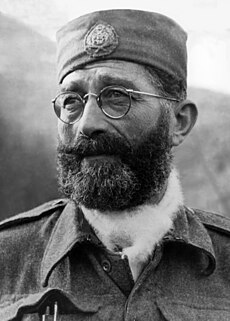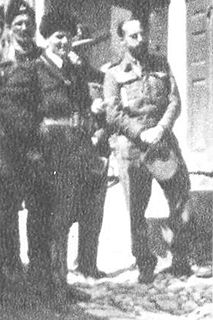Related Research Articles
The Special Operations Executive (SOE) was a secret British World War II organisation. It was officially formed on 22 July 1940 under Minister of Economic Warfare Hugh Dalton, from the amalgamation of three existing secret organisations. Its purpose was to conduct espionage, sabotage and reconnaissance in occupied Europe against the Axis powers, and to aid local resistance movements.

Dragoljub "Draža" Mihailović was a Yugoslav Serb general during World War II. He was the leader of the Chetnik Detachments of the Yugoslav Army (Chetniks), a royalist and nationalist movement and guerrilla force established following the German invasion of Yugoslavia in 1941.

Case Black, also known as the Fifth Enemy Offensive in Yugoslav historiography and often identified with its final phase, the Battle of the Sutjeska was a joint attack by the Axis taking place from 15 May to 16 June 1943, which aimed to destroy the main Yugoslav Partisan force, near the Sutjeska river in south-eastern Bosnia. The failure of the offensive marked a turning point for Yugoslavia during World War II. It was also the last major German-Italian joint operation against the partisans.

Colonel Duane Tyrell "Bill" Hudson, was a British Special Operations Executive officer who worked as a liaison officer with the Yugoslav Partisans and Chetniks in occupied Yugoslavia during World War II.

Operation Uzice was the first major counter-insurgency operation by the German Wehrmacht on the occupied territory of the Kingdom of Yugoslavia during World War II. The operation was directed against the Užice Republic, the first of several "free territories" liberated by the Yugoslav Partisans. It was named after the town of Užice, and is associated with the First Enemy Offensive in Yugoslavian historiography. The security forces of the German-installed puppet regime of Milan Nedić also participated in the offensive.
Operation Typical was the name of the first World War II British mission fully assigned to Yugoslav Partisans HQ and Marshall Tito organised by the Special Operations Executive (SOE). The six soldiers flew from Derna airfield on 27 May 1943 and parachuted to Black Lake in Montenegro at the height of a large German offensive Operation Schwarz which aimed to destroy the Partisan forces. The group was led by Col William Deakin and Capt William F Stuart, together with the two radio operators - Sergeants Walter Wroughton and Peretz 'Rose' Rosenberg. Canadian-Yugoslav Ivan ('John') Starčević acted as a translator and Sgt John Campbell (RM) was a cipher clerk, and bodyguard.

Operation Halyard, known in Serbian as Operation Air Bridge, was an Allied airlift operation behind Axis lines during World War II. In July 1944, the Office of Strategic Services (OSS) drew up plans to send a team to the Chetniks force led by General Draža Mihailović in the German-occupied Territory of the Military Commander in Serbia for the purpose of evacuating Allied airmen shot down over that area. This team, known as the Halyard team, was commanded by Lieutenant George Musulin, along with Master Sergeant Michael Rajacich, and Specialist Arthur Jibilian, the radio operator. The team was detailed to the United States Fifteenth Air Force and designated as the 1st Air Crew Rescue Unit. It was the largest rescue operation of American Airmen in history. According to historian Professor Jozo Tomasevich, a report submitted to the OSS showed that 417 Allied airmen who had been downed over occupied Yugoslavia were rescued by Mihailović's Chetniks, and airlifted out by the Fifteenth Air Force. According to Lt. Cmdr. Richard M. Kelly (OSS), a grand total of 432 U.S. and 80 Allied personnel were airlifted during the Halyard Mission.
In 1941 when the Axis invaded Yugoslavia, King Peter II formed a Government in exile in London, and in January 1942 the royalist Draža Mihailović became the Minister of War with British backing. But by June or July 1943, British Prime Minister Winston Churchill had decided to withdraw support from Mihailović and the Chetniks he led, and support the Partisans headed by Josip Broz Tito, even though this would result in "complete communist control of Serbia". The main reason for the change was not the reports by Fitzroy Maclean or William Deakin, or as later alleged the influence of James Klugmann in Special Operations Executive (SOE) headquarters in Cairo or even Randolph Churchill, but the evidence of Ultra decrypts from the Government Code and Cipher School in Bletchley Park that Tito's Partisans were a "much more effective and reliable ally in the war against Germany". Nor was it due to claims that the Chetniks were collaborating with the enemy, though there was some evidence from decrypts of collaboration with Italian and sometimes German forces.
Operation Hydra was a failed British attempt during World War II in Yugoslavia to develop contact with the Partisans led by Josip Broz Tito, in Montenegro in February 1942.
Operation Bullseye was the code-name of the first Special Operations Executive (SOE) mission to Yugoslavia since its occupation by the Axis forces. It was led by Capt D.T. Bill Hudson with the objective to discover what was happening in Yugoslavia and co-ordinate all forces of resistance there. The mission also included three Royal Yugoslav Army (RYA) officers from Montenegro: Maj Mirko Lalatović, Maj Zaharije Ostojić and Sgt Veljko Dragićević the wireless transmitter (W/T) operator. The group boarded the submarine HMS Triumph in Malta and reached Petrovac on the Montenegrin coast on 20th Sep 1941.

Arthur Terence Atherton was a British journalist, War correspondent and a newspaper proprietor of various English language publications in Belgrade between 1931 and 1941. He was also a British Special Operations Executive intelligence officer for Section D and an espionage agent, both in pre-war Belgrade and during World War II in Yugoslavia. The former journalist led a Commando Mission behind enemy lines during World War II and died in mysterious circumstances.
Mission Greenwood–Rootham was a World War II Special Operations Executive (SOE) expedition to the Yugoslav Army in the Fatherland (Chetniks) in Homolje district of Eastern Serbia near the border with Romania. The group was led by Major Erik Greenwood, Major Jasper Rootham and included Sergeant W. Anderson (W/T), Sergeant C. E. Hall (RAF) (W/T), Lieutenant E. "Micky" Hargreaves and a Royal Yugoslav Army (RYA) officer code-named "Arlo".
The Maclean Mission (MACMIS) was a World War II British mission to Yugoslav partisans HQ and Marshall Tito organised by the Special Operations Executive (SOE) in September 1943. Its aim was to assess the value of the partisans contribution to the Allied cause and the means to increase it. It was led by a recently promoted Brigadier Fitzroy Maclean and was first such mission with full authorization and a personal message from Winston Churchill. His memoir of these years forms the final third of Eastern Approaches (1949).

Peretz Rosenberg was one of the early parachutists of Mandatory Palestine. As the radio operator of special forces leader William Deakin, he was parachuted into Yugoslavia in 1943 on a mission to reach the headquarters of Tito. After World War II, he became head of the clandestine radio service of the Haganah. Rosenberg was the inventor of many agricultural water-saving devices.
Operation Fungus was one of the two Special Operations Executive (SOE) exploratory missions to Yugoslav Partisans during the World War Two. Both Operation Fungus and the second mission, Operation Hoathley 1, flew out on the night of 20 Apr 1943 from Derna airfield. The missions' objective was to establish who the Partisans were, who was their leader and if and how they could be utilised to further the Allies' military ambitions. They also served as each other's backup, in case one failed to reach the Partisans or fell into enemy's hands.

Brigadier Charles Douglas Armstrong was a British Army officer in World War I and World War II. In the latter conflict he was the head of the British Special Operations Executive (SOE) liaison mission to the Chetnik forces of Draža Mihailović in Yugoslavia from July 1943 to early 1944.
The Battle of Višegrad was the battle between Chetnik forces and Axis, and part of an Chetnik offensive in Eastern Bosnia in autumn of 1943, in Axis occupied Yugoslavia during World War II. The Chetnik forces of 2,500 captured Višegrad, destroyed big railway bridge across river Drina and continued their advances toward Rogatica and Sokolac. The German and Ustaše garrison in Višegrad and garrison that protected the bridge of total 1,100 soldiers had 350 dead and 400 wounded. The Chetniks had 21 dead and 30 wounded. In subsequent battle for Rogatica waged ten days later, the Chetniks captured Rogatica and killed more than 200 Axis soldiers.
Stanley William Bailey was a British Army officer in World War II, who reached the rank of colonel and was most notable for being the head and then political advisor of the British Special Operations Executive Liaison Mission to the Chetnik Forces of Draža Mihailović from December 25, 1942—January 29, 1944. British policy toward Mihailović was shaped by the regular reports from Bailey. Bailey's position on General Mihailović was influential in undermining the relationship between Mihailović and the Chetniks with Churchill and the British Foreign Office, and consequently with the other Allied nations.
Mission Rogers was a World War II Special Operations Executive (SOE) medical and military expedition to Yugoslav Partisans in Dalmatia, western Bosnia and Slovenia. The group was led by Major Lindsay Rogers and included Sergeant William (Bill) Gillanders RAMC and an RAF Sergeant Ian McGregor. Codenamed "Vaseline" the mission left southern Italy in a Royal Navy submarine and reached the island of Vis in late November 1943.
Mission Davidson was a World War II Special Operations Executive (SOE) military expedition to Yugoslav Partisans led by Basil Davidson, a peacetime journalist, Sergeant William Ennis and a wireless operator Sergeant Stanley Brandreth. Codenamed "Savannah", the mission landed by parachute at Petrovo Polje in central Bosnia on 16 August 1943. They were welcomed by the local British Liaison Officer, Major William Deakin who took Davidson to meet Marshall Tito. Once he explained that his ambition was to get into Hungary, Tito suggested Davidson joins General Kosta Nađ and his troops on their way towards Belgrade.